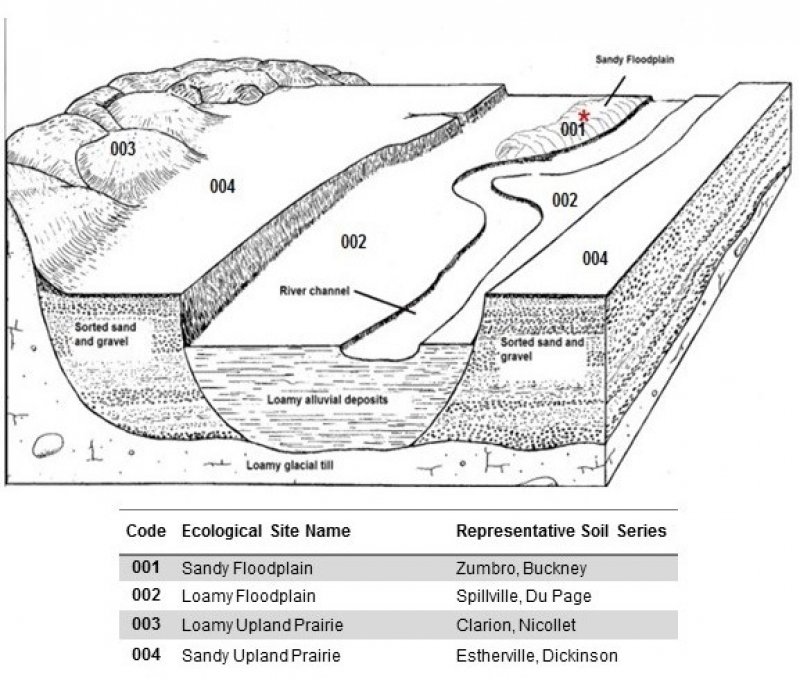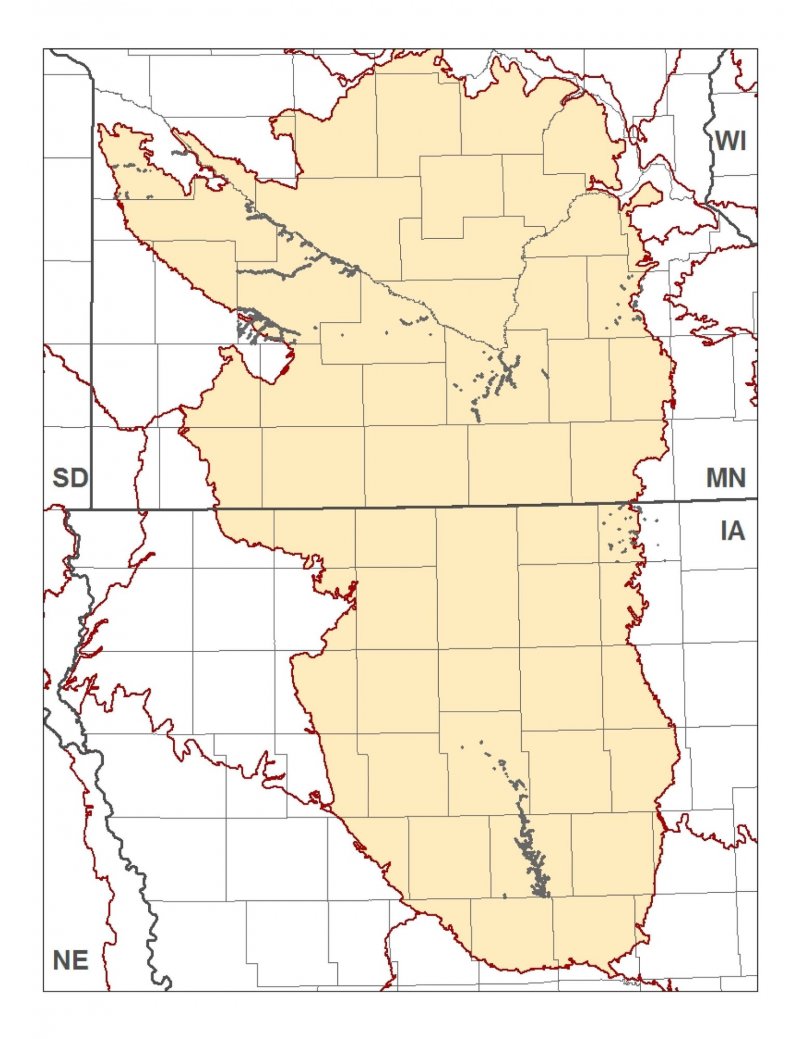
Natural Resources
Conservation Service
Ecological site F103XY031MN
Sandy Floodplains
Last updated: 10/04/2023
Accessed: 12/19/2025
General information
Provisional. A provisional ecological site description has undergone quality control and quality assurance review. It contains a working state and transition model and enough information to identify the ecological site.
MLRA notes
Major Land Resource Area (MLRA): 103X–Central Iowa and Minnesota Till Prairies
MLRA 103 is in Minnesota (56 percent) and Iowa (44 percent) and consists of approximately 18 million acres. It is in the Western Lake Section of the Central Lowland Province of the Interior Plains in an area known as the "Des Moines Lobe" of the Wisconsin-age ice sheet. The MLRA is mostly on a young, nearly level to gently rolling, glaciated till plain that has moraines and glacial lake plains in some areas. The plain is covered with glacial till, outwash, and glacial lake deposits. Recent alluvium consisting of clay, silt, sand, and gravel fill the bottoms of most of the major river valleys. Paleozoic bedrock sediments, primarily shale and limestone, underlie the glacial deposits in most of the area.
The annual precipitation increases from northwest to southeast. Most of the rainfall occurs as high-intensity, convective thunderstorms during the summer. Two-thirds or more of the precipitation falls during the freeze-free period. Snowfall is common in winter. Ground water supplies are adequate for the domestic, livestock, municipal, and industrial needs. Nearly all of this area is farmland, and about four-fifths is cropland.
Classification relationships
Major Land Resource Area (MLRA): Central Iowa and Minnesota Till Prairies (103) (USDA Handbook 296, 2006)
USFS Subregions: North Central Glaciated Plains Section (251B); Upper Minnesota River-Des Moines Lobe (251BA) and Southern Des Moines Lobe (251Be) Subsections (Cleland et al. 2007)
International Vegetation Classification Hierarchy
Class: 1. Forest & Woodland
Subclass: 1.B. Temperate & Boreal Forest & Woodland
Formation: 1.B.3. Temperate Flooded & Swamp Forest
Division: 1.B.3.Na. Eastern North American-Great Plains Flooded & Swamp Forest
The reference state shares similarities to Minnesota Department of Natural Resources FFs59 Southern Terrace Forest
Ecological site concept
The Sandy Floodplains ecological site is predominantly located on floodplains of larger rivers throughout MLRA 103. The site is influenced by the hydrologic interaction with the adjacent river which influences the depth to soil saturation. This ecological site may exhibit various plant community composition depending on flooding.
Associated sites
| F103XY032MN |
Loamy Floodplains The Loamy Floodplains ecological site is located on medium textured alluvium throughout MLRA 103. Soil textures include loam, silt loam, sandy loam, and fine sandy loam. Soils are somewhat poorly drained to moderately well drained. Some areas within this ecological site will exhibit long-term flooding (7-30 days). |
|---|---|
| R103XY003MN |
Sandy Upland Prairies The Sandy Upland Prairie ecological site is located on uplands including outwash plains and valley trains along modern river valleys. Soils are formed from sandy and course loamy outwash and loamy-mantled outwash. Sites do not flood or pond. |
| F103XY033MN |
Wet Floodplains The Wet Floodplains ecological site occurs in both floodplains and depressions and is extensive throughout MLRA 103. Soils include both Mollisols and Entisols, and soil drainage class is very poorly drained to poorly drained. Areas within this site flood frequently, and some areas may incur very long periods of flooding (over 30 days). |
| R103XY006MN |
Bedrock Controlled Upland Prairies The Bedrock Controlled Upland Prairies ecological site is characterized by shallow to moderately deep soils that are influenced by bedrock and have a low available water capacity. |
Similar sites
| F103XY032MN |
Loamy Floodplains The Loamy Floodplains ecological site is located on medium textured alluvium throughout MLRA 103. Soil textures include loam, silt loam, sandy loam, and fine sandy loam. Some areas within this ecological site will exhibit long-term flooding (7-30 days). |
|---|
Table 1. Dominant plant species
| Tree |
(1) Ulmus americana |
|---|---|
| Shrub |
Not specified |
| Herbaceous |
(1) Laportea canadensis |
Click on box and path labels to scroll to the respective text.
Ecosystem states
| T1A | - | Site is cleared, tilled, seeded, and managed for crop production |
|---|---|---|
| T1B | - | Site incurs large-scale disturbance and altered plant community |
| R3A | - | Restoration of natural hydrology; establishment of desired species; exclusion of anthropogenic disturbances; eradication of invasive species; long-term timber stand management |
| T3A | - | Site cleared, soil tillage, crop establishment, and continued agriculture management |
State 1 submodel, plant communities
State 2 submodel, plant communities
| 2.1A | - | Seeding and management of warm or cool season grasses. |
|---|---|---|
| 2.2A | - | Site preparation, soil tillage, crop establishment, weed control |


